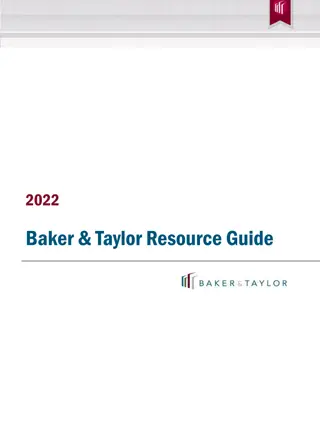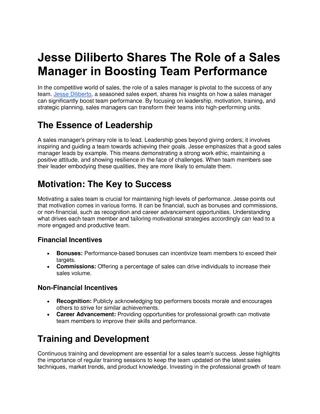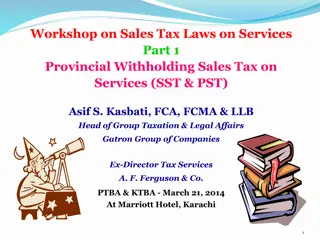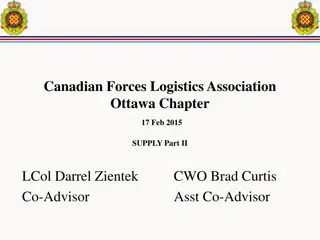Canadian Sales Processes Overview & Update - Jan 2024 Conference
Explore the statutory means and tests for implementing and approving Canadian sales processes, focusing on asset sales, share sales, and plan sales. Learn about key considerations and factors involved in the approval process under the CCAA framework. The overview covers the basics and the legal requirements for conducting sales in Canada as part of this comprehensive update presented at the North American Regional Conference 2024.
Download Presentation

Please find below an Image/Link to download the presentation.
The content on the website is provided AS IS for your information and personal use only. It may not be sold, licensed, or shared on other websites without obtaining consent from the author. Download presentation by click this link. If you encounter any issues during the download, it is possible that the publisher has removed the file from their server.
E N D
Presentation Transcript
Overview and Update on Canadian Sales Processes January 2024 III North American Regional Conference 2024
Part I Overview of Canadian Sale Processes Overview of Canadian Sale Overview of Canadian Sale Processes Processes 1
Key Statutory Means of Implementing a Canadian Sale Sales of assets or businesses can occur in a number of different ways in Canada: 1. Through an asset sale in any of a CCAA restructuring or liquidation (like Chapter 11), a BIA bankruptcy proceeding (like Chapter 7) or a Receivership with an Approval and Vesting Order 2. As a share salethrough any of the above with a Reverse Vesting Order 3. Or though a plan sale, typically done through a plan of arrangement in a CCAA Part IV of the CCAA allows for recognition of a US-based sale Canadian-based sales have been recognized in the US in a number of Chapter 15 cases more on this later 2
Basic Statutory Test for Approving a Canadian Sale Under s. 36 of the CCAA, the Court may authorize the debtor to sell or otherwise dispose of its assets outside of the ordinary course of business free and clear of any security, charge or other restriction. In deciding whether to exercise its discretion to approve the Transaction, the Court must review the Transaction as a whole and decide whether it is appropriate, fair, and reasonable. This determination is made in the context of the primary objectives of the CCAA (or BIA), which include avoiding the devastating social and economic costs of liquidation of a debtor company s assets. Section 36(3) of the CCAA (section 65.13 BIA is similar)provides a non-exhaustive list of factors to be considered: whether the process leading to the proposed sale or disposition was reasonable in the circumstances whether the Monitor approved the process leading to the proposed sale or disposition. whether the Monitor filed with the court a report stating that in their opinion the sale or disposition would be more beneficial to the creditors than a sale or disposition under a bankruptcy the extent to which the creditors were consulted the effects of the proposed sale or disposition on the creditors and other interested parties whether the consideration to be received for the assets is reasonable and fair, taking into account their market value 3
Basic Statutory Test for Approving a Canadian Sale The s. 36(3) factors are not intended to be exhaustive and the principles established in Royal Bank v. Soundair Corp. for approval of a sale in an insolvency proceeding remain relevant. Applying these Soundair principles, courts examine: whether the party conducting the sale made sufficient efforts to obtain the best price and did not act improvidently; the interests of all parties; the efficacy and integrity of the process by which offers were obtained; and whether there has been unfairness in the working out of the process 4
Key Features of Canadian Sales There are several distinct aspects of Canadian sales process that are worth discussing and considering: 1. Pre-Filing Sales and One-Day Proceedings In Canada, in the right circumstances, we have the ability to conduct the sale process entirely pre-filing (therefore non-public), and simply have the result approved by the court in essentially a one day hearing This approach is used where: There is only one buyer and so no legitimate reason to put the business through a public bankruptcy sale process; The negative effect of a public bankruptcy sale process would simply be too great, all things considered In these cases, the court will apply a greater level of scrutiny to the sale approval application 2. Asset sale or share sale Denis will discuss this in great detail next 5
Key Features of Canadian Sales 3. Significant flexibility on the style of SISP we use thick or thin? Key considerations will be: Stalking horse or no stalking horse? Not just a question of whether we can get one But rather, should we have one? What will the effect be on other bidders? Will the bids really be apples to apples? Would anyone really rely on the diligence done by the SHB? Will an SHB attract or scare off other bidders? The break-up fee Balance between creating auction tension (through lack of transparency) versus risk management / protectionism through full transparency Many of the transparency provisions of a typical SISP tend to reduce not augment competitive tension Why are we doing it? Use of live auction at end rarely done but generally provided for in SISP; never done in a public context, so why do here? Who conducts the sale? Financial advisor or court-appointed Monitor? Success fee or no success fee? 6
Part II Canadian Sales Orders the AVO and the RVO The Approval and Vesting The Approval and Vesting Order Order 7
Key Terms of a Standard Approval and Vesting Order A standard approval and vesting order will contain the following terms and conditions, among others: 1. Court Authorization- The transaction is Court authorized and the hearing is public. Conditions of sale typically public upon closing but fulsome creditors have access to those terms. Hearing is public and notice has to be given. 2. Free and clear - The assets are vested in the purchaser free and clear of all rights, liens, claims and encumbrances, etc all of which are transferred from the assets to the proceeds of sale. 3. Protected transaction transaction cannot be subsequently attacked as a transfer at undervalue, through any avoidance action powers or otherwise. 4. Court-ordered third party releases for all parties involved in the sale transaction. 5. Procedures for the assumption of purchased contracts and the payment of cure costs 6. Assignment of agreements can be forced Subject to cure costs. 7. Clear disposal of unwanted liabilities and contracts, leases, etc. 8. No creditors vote The Court authorization suffices. This is all very similar to a 363 sale approval order under Chapter 11 8
Part II Canadian Sales Orders the AVO and the RVO The Reverse Vesting Order The Reverse Vesting Order 9
Reverse Vesting Order In recent years, a new form of effecting a sale transaction has emerged in Canadian restructurings, which is implemented through a reverse vesting order ( RVO ) An RVO facilitates the acquisition of the shares of a restructured debtor company that is cleansed of all unwanted assets, liabilities and obligations pursuant to the RVO. The RVO requires only court approval. It does not require any votes or approvals by creditors or shareholders. The RVO structure enables the completion of a comprehensive corporate restructuring in a timely manner and enables the debtor to retain and maximize the value of assets that are not easily transferrable (such as key contracts, licenses, permits, and tax attributes). Canadian courts have the jurisdiction to grant RVOs in appropriate cases but have cautioned that RVOs should not be considered routine or ordinary course. In the 2022 decision in Harte Gold Corp., the Ontario Court developed a set of factors that courts are to consider in determining whether to approve a particular RVO transaction. 10
Process and Structure To undertake a RVO transaction, parties enter into a transaction agreement specifying: the Newco entity that will act as the ResidualCo for purposes of the transaction, which can be a new or existing corporation (subject to addressing director/officer matters) or a trust; the entity or entities whose shares will be acquired (the Acquired Entity ); the assets that the Acquired Entity will retain at closing (the Retained Assets ); the unwanted obligations that the Acquired Entity will not assume (the Excluded Liabilities ); and the obligations, if any, that the Acquired Entity will retain at closing. The RVO gives effect to the transaction by: approving the purchaser s acquisition of the shares of the Acquired Entity on a free and clear basis (and cancelling all other equity interests in the Acquired Entity); vesting/transferring all Excluded Liabilities and any unwanted assets in ResidualCo, which is subsequently wound-down and liquidated; and releasing the Acquired Entity from the Excluded Liabilities and all related claims and encumbrances. Upon completion of the RVO transaction: the purchaser is the holder of the Acquired Entity s shares; the Acquired Entity continues to own all Retained Assets; the Acquired Entity has been cleansed of all unwanted assets and liabilities; and the Acquired Entity emerges from CCAA protection. 11
Traditional Vesting Order *In a traditional Vesting Order, the purchased assets vest out of the debtor company into the new buyer entity Assets + Assumed Liabilities and Contracts are transferred Free and Clear to NewCO Buyer NewCo Receives: - Assets + Assumed Liabilities + Contracts Potential Issues: - Need for New Permits + New Licenses - Asset conveyancing/transfer taxes - Loss of tax attributes Debtor Company Retains: Unassumed Liabilities + liens Liens are applied to Purchase Price (in place of assets/collateral) - - - Purchase Price 12
Reverse Vesting Order *In a Reverse Vesting Order, the unwanted liabilities are vested out of the debtor company into a newly formed company, offering the buyer numerous advantages Buyer - - Receives: Debtor Company that has been cleansed by RVO Purchase Price ResidualCo Can be administered by Monitor Receives: Unassumed Liabilities & Liens Excluded Assets Purchase Price Debtor Company Retains: Assets, Contracts, Assumed Liabilities, Permits, Licenses Tax attributes (e.g. tax losses) - - - - - - - - Purchase Price transferred to ResidualCo 13
Key Benefits Timeliness and Efficiency Timeline similar to an asset sale transaction No creditor or shareholder vote required Solution to Asset Transfer and Assignment Issues No need to assign/transfer purchased assets to a new entity (and no transfer taxes) Solution for certain assets that cannot be transferred (e.g. licenses and permits) Change of control rights can be stayed by court order Preservation of Tax Attributes Preserves key tax attributes such as tax losses and paid-up capital, which can be used by the Acquired Entity on a go-forward basis (subject to any consequences arising from the transaction, such as debt forgiveness or loss streaming implications). Other tax-driven corporate reorganization steps can be completed as part of RVO transaction. Flexibility Similar to a typical asset sale transaction, purchaser has the ability to cherry pick good assets and acquire them free and clear of liabilities and encumbrances. Releases RVOs have included releases for directors and officers and other third parties in appropriate cases. 14
Case Law and Authority CANADA As discussed, when considering approval of a sale transaction, Canadian courts will review the factors set out in section 36 of the CCAA (fairness of the process, reasonableness of the consideration, impact on creditors, etc.) In the 2022 Harte Gold Corp. decision, the Ontario Court indicated that courts will consider the following additional factors in deciding whether to approve an RVO transaction: Why is the RVO necessary in this case? Does the RVO structure produce an economic result at least as favourable as any other viable alternative? Is any stakeholder worse off under the RVO structure than they would have been under any other viable alternative? Does the consideration being paid for the debtor s business reflect the importance and value of the intangible assets being preserved under the RVO structure? UNITED STATES In December 2022, the Bankruptcy Court in the Just Energy proceedings granted Chapter 15 recognition to Canadian sale procedures that were based on a stalking horse transaction to be implemented through an RVO - In re Just Energy Group, Inc., Case No. 21-30823 (Bankr. S.D. Tex.) [Docket No. 232] RVOs have now also been recognized in three other Chapter 15 cases: In re NextPoint Financial Inc., Case No. 23-10983 (Bankr. D. Del.) [Docket No. 155] In re Acerus Pharmaceuticals Corporation, Case No. 23-10111 (Bankr. D. Del.) [Docket No. 78] In re Dynamic Technologies Inc., Case No. 23-41416 (Bankr. N.D. Tex.) [Docket No. 59] 15























